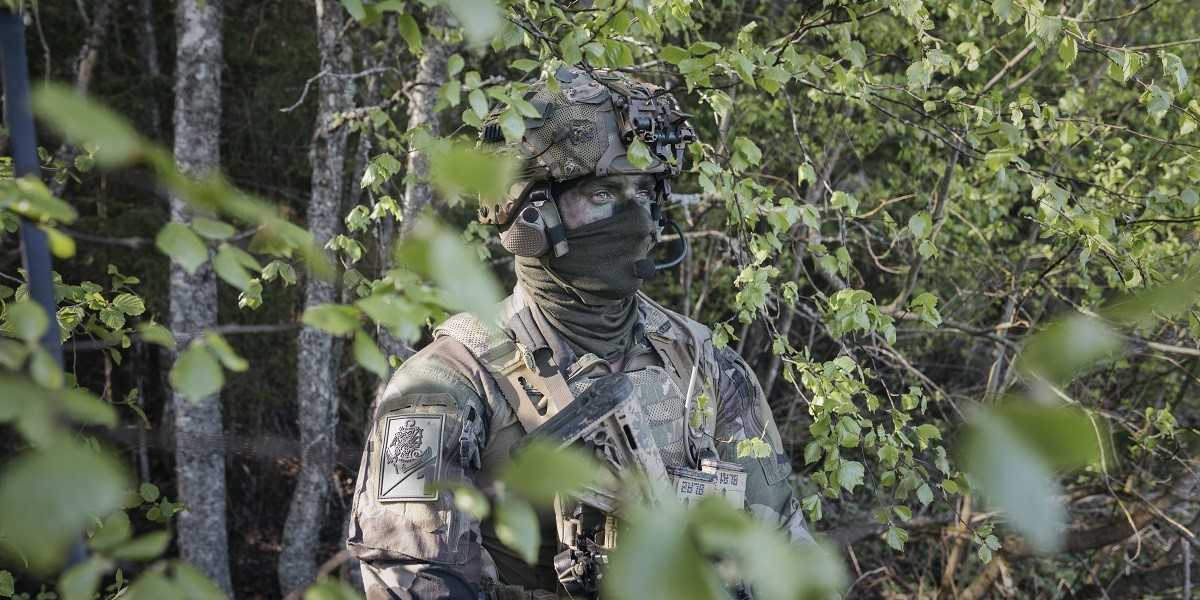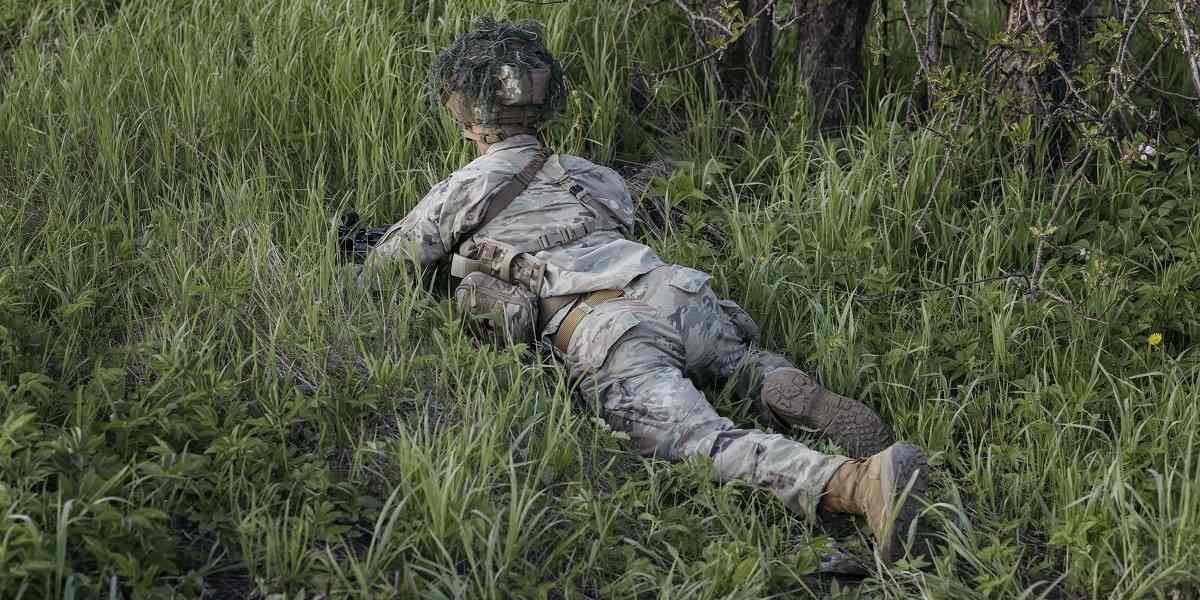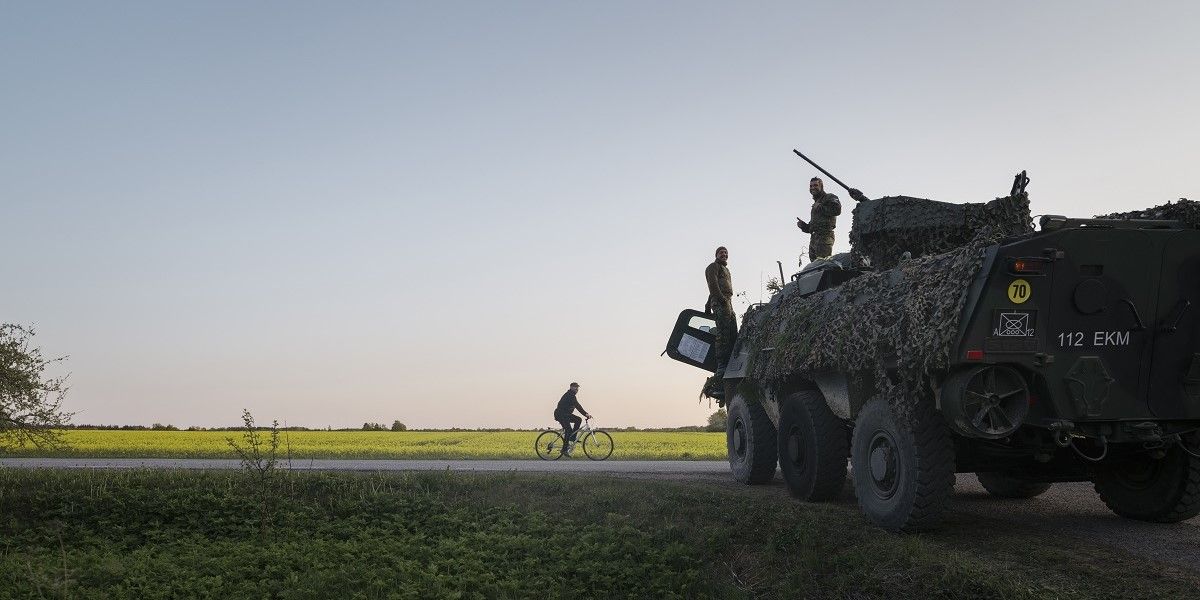
French forces parachute into Viitna, Estonia, as part of training exercises on May 20.
11:33 JST, June 6, 2023
VIITNA, Estonia – They left France in the early hours, flying north and east over sleeping cities until they were less than 100 miles from the Russian border. Then, they jumped.
The French paratroopers who floated into the fields of Estonia in May were part of a stepped-up rehearsal of what it would take to reinforce a battle group if the country – and NATO – were attacked.

A French paratrooper participates in training in Estonia.
Before Russia launched its invasion of Ukraine last year, the multinational troops stationed in the Baltics and Poland were intended as a “tripwire” – a presence just large enough to signal that any aggression would be met with a collective response, and just capable enough to hope to slow down enemy forces until reinforcements arrived.
Now, as part of what NATO bills as its “biggest overhaul” since the Cold War, the alliance claims that it intends to defend “every inch” of its territory from Day One. That is meant as a message to Moscow, as well as reassurance for countries that feared being left to languish under Russian occupation. “How it works is to give a very clear signal to Russia that we are so ready, don’t even think about us,” Estonian Prime Minister Kaja Kallas said in an interview with The Washington Post.
That’s the idea, at least. Roughly a year in, an energized and expanded NATO has more soldiers in allied countries closest to Russia. It is training standby troops to deploy to border states more rapidly. And it is starting to pre-position the kind of heavy weapons and equipment that can’t fit in a paratrooper’s pack.
Yet NATO hasn’t committed to the level of permanent on-the-ground troops that some nations wanted. And interviews with more than a dozen senior officials, as well as former officials and analysts, suggest that the overhaul still has a ways to go before the alliance could repel Russia without losing an inch of territory.
“Being faster than the Russians to get to a critical place is the only metric that matters for effective deterrence, and we still can’t do that,” said retired U.S. Army Lt. Gen. Ben Hodges, a former commander of U.S. Army Europe.
“Military mobility is still a problem,” he said. “It is better than it was five years ago, but that’s not the metric that matters.”
Since Russia’s full-scale invasion of Ukraine, NATO has bolstered its eastern flank in part by establishing battle groups in four additional countries: Bulgaria, Hungary, Romania and Slovakia. There are now about 10,000 troops spread across eight battle groups, compared with 5,000 in four groups in 2021, according NATO spokesperson Oana Lungescu.
Lungescu said allies have also sent dozens more ships and hundreds more planes to the eastern part of the alliance – especially important for the Baltic nations, which don’t have their own fighter jets.
Allies have additionally deployed an “unprecedented” number of ground-based air defenses, such as Patriot missiles, and air-defense-capable ships at sea, she added.
Other aspects of the strengthened posture are still under debate.
Secretary General Jens Stoltenberg said ahead of last year’s NATO summit that the alliance would “enhance” battle groups in the eastern part of the alliance from battalion to brigade level – which generally means, Lungescu said, going from about 1,000 troops to 3,000 or more. The summit declaration, however, hedged that the scale-up would take place “where and when required,” leaving allies to argue over what “required” means in practice.
While past concerns about provoking Moscow with too large a presence have receded, some allies say that a bigger presence isn’t worth the expense and could limit NATO’s flexibility.
Germany, for instance, which leads the battle group in Lithuania, has opposed calls for a permanent brigade there, saying it makes more sense to keep standby forces on German bases. The German military sent another 20 soldiers to Lithuania as a “forward command element” of an additional brigade. Nearly 6,000 more could be there “if necessary,” a spokesperson said, “within the shortest possible time.”
Lithuanian officials counter that because of the country’s geography, Russia could cut it off quickly, with little time for reinforcements to arrive.
The plan for rapid reinforcements is itself a work in progress.
Stoltenberg made headlines last June with an announcement that the alliance was putting 300,000 troops on high readiness – up from 40,000. Under this new force model, NATO said, troops would be pre-assigned to particular countries, with 100,000 troops deployable within 10 days and an additional 200,000 within 30 days.
The announcement appeared to catch some European defense officials by surprise, and left them wondering if or how their troops were being counted. Almost immediately, NATO officials offered caveats. The overall target number was still conceptual, they said, and national commitments needed to be negotiated. “The train left the station before the tracks were built,” Tomas Jermalavicius, head of studies and research fellow at Estonia’s International Center for Defence and Security, recently told The Post.
Discussion of the proposed new force structure – including which troops would be pre-assigned to protect which countries and what level of readiness they would need to maintain – is on the agenda for the NATO leaders’ summit in Vilnius, the Lithuanian capital, next month.
Officials overseeing the recent exercises in Estonia said training together is important, but further readiness is contingent on knowing which troops would actually be deployed to protect them in a crisis.
“We need to know exactly . . . these units which are coming, to be interoperable, to exercise with them . . . how we receive them, how we move them, how we staged them,” said Gen. Martin Herem, military chief of the Estonian defense forces. “That makes everything very fast. If you haven’t done it right, that takes time. Not days, but weeks.”
Estonian military officials say they would like more detail on what might trigger deployments. “We need reinforcements not when Russian aggression starts, but from the moment we see the first indicators and warnings,” Herem said.
Estonian officials are also looking for specific guarantees that the multinational battle group based here will stick around.
“Right now we have bilateral agreements with those countries, and we want to have it in NATO’s plans so that if, you know, one country decides to withdraw their troops here, there’s somebody else coming in,” Kallas said.

Estonian defense officials said the training was important for readiness, but they want to know which countries’ troops would actually be deployed to protect them.
The prime minister is pushing others to follow Estonia’s lead in upping military spending to 3 percent of gross domestic product next year. Many allies, though, still aren’t even meeting the NATO standard of 2 percent of GDP. Some countries, Kallas said, hold out hope “that this problem will go away and they don’t actually have to invest in defense.”
Estonia and other nations in Central and Eastern Europe see the threat from Russia as real and existential.
“I think Russia is on a trajectory to conflict or to war with NATO,” Gen. Karel Rehka, chief of the general staff of the Czech Republic, said in an interview in Tallinn, the Estonian capital. “That doesn’t mean they’re planning to do it. NATO doesn’t want to go to war with Russia, just as Russia doesn’t want to go to war with NATO. But that doesn’t mean it cannot happen. There’ve been many wars that no one really planned to have.”
Rehka said he was troubled by the swell of nationalist sentiment in Russia and President Vladimir Putin’s announced plans to expand his military. “Regardless of how the war ends” in Ukraine, Rehka said, “Russia will be more hostile towards us and less predictable.”
Being ready to defend against an enemy like Russia requires conventional military might, Herem said: “Bombs, not cyber.”
Analysts said that to provide credible deterrence and defense, Europe will need to invest in military logistics. Hodges, the former commander of U.S. Army Europe, said there are simply not enough train cars that can carry armored vehicles, or bridges and tunnels wide enough for the stuff of modern warfare.
There is diplomatic work to be done, too. Hodges sees a need for something like a “military Schengen zone” – like Europe’s borderless travel and trade zone – that would allow NATO military convoys to “cross borders with the same ease as truckloads of apples.”

U.S. troops play the part of the opponent in the exercise.
Building trust is also key, said Camille Grand, a Frenchman who was until last year NATO’s assistant secretary general for defense investment and is now a distinguished policy fellow with the European Council on Foreign Relations.
The disagreement between Germany and Lithuania over troop levels “has to do with political and military trust,” he said. The Lithuanians worry that German reinforcements might be held up by political delays or might show up lacking the relevant capabilities, he said. “This is why the Lithuanians are pushing so hard to ask, ‘Are they worth their word?'”
Lungescu, the NATO spokesperson, said German troops this month will practice reinforcing Lithuania’s battle group to brigade level. The alliance’s efforts “strike the right balance between a greater military forward presence and the ability to quickly send reinforcements,” she said. “There should be no misunderstanding about NATO’s will and ability to protect every ally.”
Estonian officials say they trust that NATO would come to their aid and that the alliance would ultimately prevail in any conflict with Russia.
“I am quite sure that if Russia acts, then NATO will win,” Herem said. “However, if you look at a map, then how much of Estonia and for how long will we have to cede territory?”
He continued: “There will be books about how small, heroic Ukraine defended against Russia and was successful. If you go deeper, and look at what they have lost, it’s a tragedy.”
“To avoid this, we must be much more ready than we are today.”

Estonian soldiers chat with a local.
"News Services" POPULAR ARTICLE
-

American Playwright Jeremy O. Harris Arrested in Japan on Alleged Drug Smuggling
-

Japan’s Nikkei Stock Average as JGB Yields, Yen Rise on Rate-Hike Bets
-

Japan’s Nikkei Stock Average Licks Wounds after Selloff Sparked by BOJ Hike Bets (UPDATE 1)
-

Japan’s Nikkei Stock Average Buoyed by Stable Yen; SoftBank’s Slide Caps Gains (UPDATE 1)
-

Japanese Bond Yields Zoom, Stocks Slide as Rate Hike Looms
JN ACCESS RANKING
-

Keidanren Chairman Yoshinobu Tsutsui Visits Kashiwazaki-Kariwa Nuclear Power Plant; Inspects New Emergency Safety System
-

Imports of Rare Earths from China Facing Delays, May Be Caused by Deterioration of Japan-China Relations
-

University of Tokyo Professor Discusses Japanese Economic Security in Interview Ahead of Forum
-

Japan Pulls out of Vietnam Nuclear Project, Complicating Hanoi’s Power Plans
-

Govt Aims to Expand NISA Program Lineup, Abolish Age Restriction



















